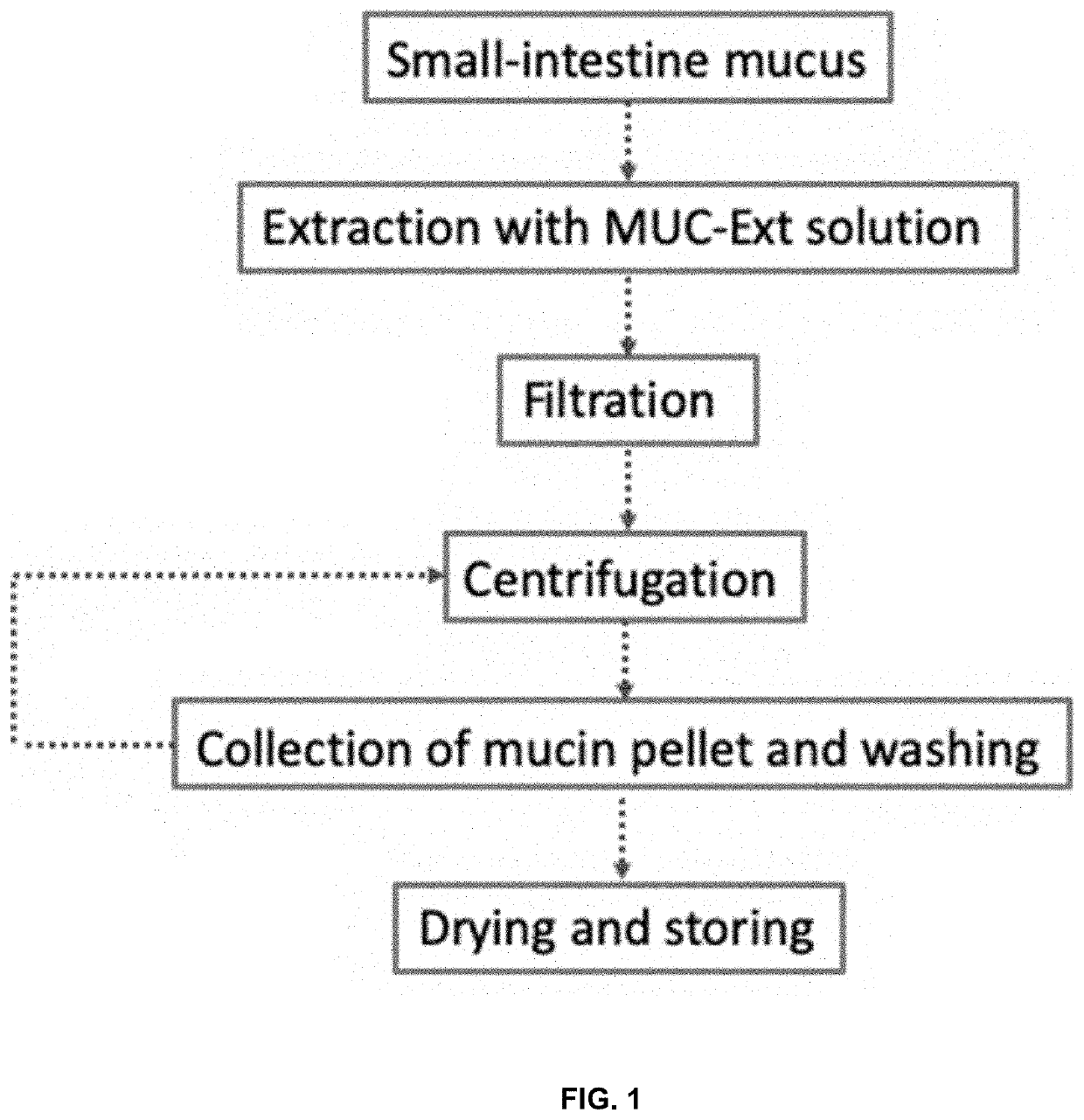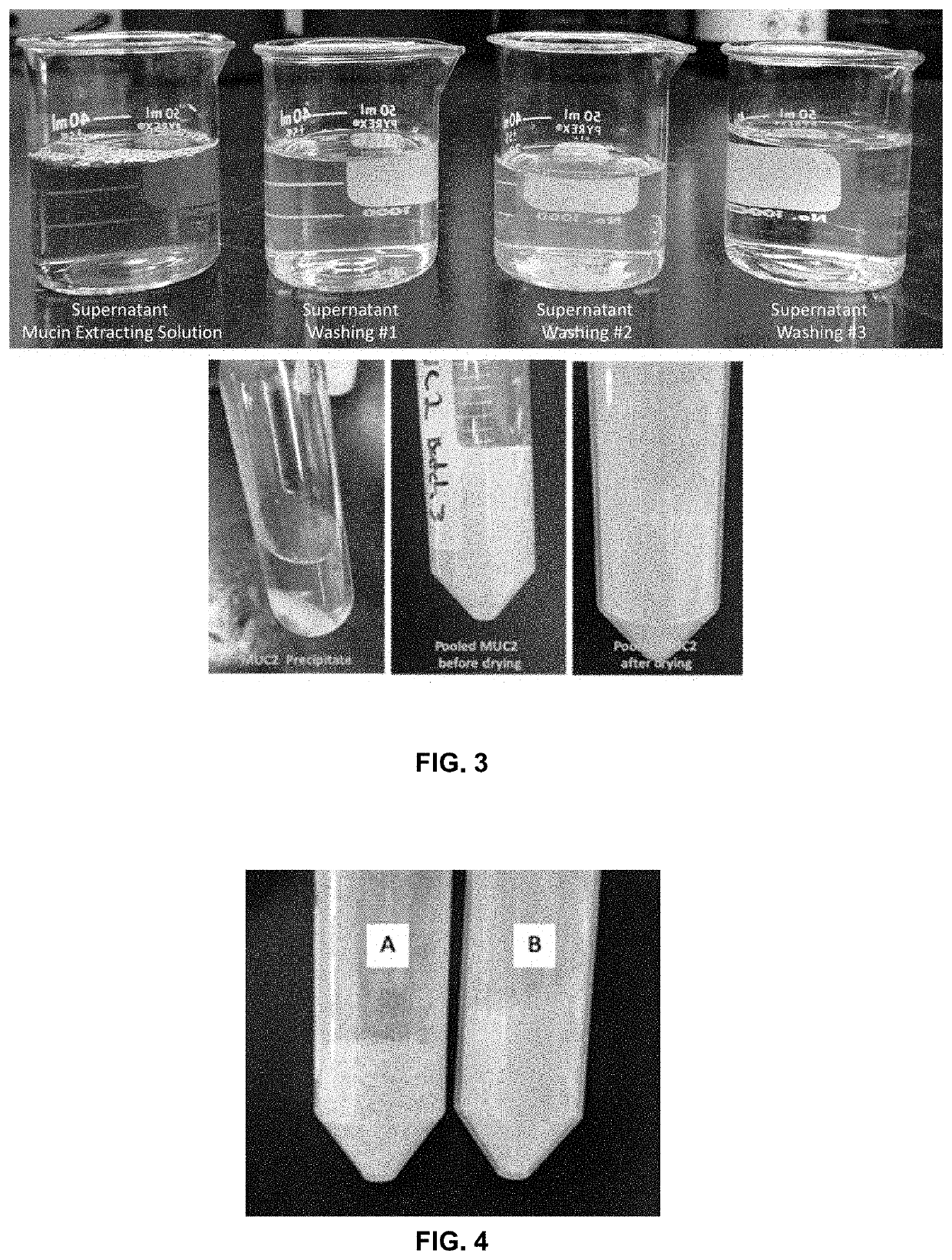Methods of purifying mucin
a technology of mucin and purification method, which is applied in the field of purification method and purification method, can solve problems affecting the overall bioactivity of mucin, and achieve the effect of rapid and inexpensive methods of purification method
- Summary
- Abstract
- Description
- Claims
- Application Information
AI Technical Summary
Benefits of technology
Problems solved by technology
Method used
Image
Examples
example 1
d
[0072]Mucins are a family of high molecular weight, heavily glycosylated proteins (glycoproteins) produced by epithelial tissues in most animals. See Bansil et al. (Bansil R, Turner B S. Mucin structure, aggregation, physiological functions and biomedical applications. Current Opinion in Colloid & Interface Science, 2006, 11(2-3):164-170) and Authimoolam et al. (Authimoolam S P, Dziubla T D. Biopolymeric Mucin and Synthetic Polymer Analogs: Their Structure, Function and Role in Biomedical Applications. Polymers, 2016, 8(3), 71) for structural and functional aspects of mucins. Mucins are a critical component of the mucus that coats the surfaces of cells lining the respiratory, digestive, and urogenital tracts. Mucus protects epithelial cells from infection, dehydration, and physical or chemical injury, as well as aids the passage of materials through a tract. Mucin 2 (MUC2, encoded by the MUC2 gene) is the most abundant mucin in the small intestine of mice, rats, swine and humans. U...
example 2
on of Mucin Extracting Solution (MUC-Ext)
[0076]A purification solution, referred to in the present examples as “Mucin Extracting Solution” or “MUC-Ext,” was prepared according the formula provided in Table 1.
TABLE 1Master Formula for Preparation of MucinExtracting Solution (MUC-Ext)*.IngredientComposition in (1000 mL)Sodium laurel sulfate10-30gEthylenediamine tetracetic acid10-20gSodium hydroxide3-10gSodium borate decahydrate3-10gDisodium hydrogen phosphate1-5gEthylene glycol mono ethyl ether5-15gWaterTo complete volume*pH of solution regulated to 7.0. EDTA and NaOH can be replaced by EDTA disodium salt (5-20 g).
To prepare the Mucin Extracting Solution, the EDTA and sodium borate were placed together in a large beaker with some of the distilled water and were heated until dissolved. The sodium lauryl sulfate and ethylene glycol mono ethyl ether were then added to the solution. The disodium hydrogen phosphate was then added in a separate beaker with some of the distilled water, heate...
example 3
ion of Mucin from Swine Small Intestine Mucus with the Mucin Extracting Solution
[0077]Mucin was isolated from swine small intestine mucus with the Mucin Extracting Solution. Swine small intestines were obtained from a local abattoir, placed on ice, and transported back to the lab for processing. The small intestines were cut into 1-meter sections. Each section was cut longitudinally and laid flat to expose the lumen of the intestine. Using a spatula / putty knife, the mucosal surface of each section was lightly scraped to obtain mucus, and the mucus was collected into a beaker. Materials from multiple intestinal sections were pooled together.
[0078]Once sufficient material was collected, the mucus was combined with Mucin Extracting Solution (MUC-Ext) (Table 1) at a ratio of 1:10 (vol. mucus:vol. MUC-Ext) and allowed to mix on an orbital shaker for 1 hour at room temperature to ensure sufficient mixing.
[0079]After the 1 hour of mixing, the mixed material was poured through a sieve (i.e....
PUM
| Property | Measurement | Unit |
|---|---|---|
| temperature | aaaaa | aaaaa |
| temperature | aaaaa | aaaaa |
| temperature | aaaaa | aaaaa |
Abstract
Description
Claims
Application Information
 Login to View More
Login to View More - R&D
- Intellectual Property
- Life Sciences
- Materials
- Tech Scout
- Unparalleled Data Quality
- Higher Quality Content
- 60% Fewer Hallucinations
Browse by: Latest US Patents, China's latest patents, Technical Efficacy Thesaurus, Application Domain, Technology Topic, Popular Technical Reports.
© 2025 PatSnap. All rights reserved.Legal|Privacy policy|Modern Slavery Act Transparency Statement|Sitemap|About US| Contact US: help@patsnap.com



